
Ploidy is the number of complete sets of chromosomes in a cell, and hence the number of possible alleles for autosomal and pseudoautosomal genes. Sets of chromosomes refer to the number of maternal and paternal chromosome copies, respectively, in each homologous chromosome pair, which chromosomes naturally exist as. Somatic cells, tissues, and individual organisms can be described according to the number of sets of chromosomes present : monoploid, diploid, triploid, tetraploid, pentaploid, hexaploid, heptaploid or septaploid, etc. The generic term polyploid is often used to describe cells with three or more sets of chromosomes.

Fragaria is a genus of flowering plants in the rose family, Rosaceae, commonly known as strawberries for their edible fruits. There are more than 20 described species and many hybrids and cultivars. The most common strawberries grown commercially are cultivars of the garden strawberry, a hybrid known as Fragaria × ananassa. Strawberries have a taste that varies by cultivar, and ranges from quite sweet to rather tart. Strawberries are an important commercial fruit crop, widely grown in all temperate regions of the world.

Vascular plants, also called tracheophytes or collectively tracheophyta, form a large group of land plants that have lignified tissues for conducting water and minerals throughout the plant. They also have a specialized non-lignified tissue to conduct products of photosynthesis. Vascular plants include the clubmosses, horsetails, ferns, gymnosperms, and angiosperms. Scientific names for the group include Tracheophyta, Tracheobionta and Equisetopsida sensu lato. Some early land plants had less developed vascular tissue; the term eutracheophyte has been used for all other vascular plants, including all living ones.

A daylily, day lily or ditch-lily is a flowering plant in the genus Hemerocallis, a member of the family Asphodelaceae, subfamily Hemerocallidoideae, native to Asia. Despite the common name, it is not, in fact, a lily, nor does it specifically grow in ditches. Gardening enthusiasts and horticulturists have long bred Hemerocallis species for their attractive flowers; a select few species of the genus have edible petals, while some are extremely toxic. Thousands of cultivars have been registered by the American Daylily Society, the only internationally recognized registrant according to the International Code of Nomenclature for Cultivated Plants (ICNCP).. The plants are perennial, bulbous plants, whose common name alludes to its flowers, which typically last about a day.

The Eurasian Plate is a tectonic plate that includes most of the continent of Eurasia, with the notable exceptions of the Indian subcontinent, the Arabian subcontinent and the area east of the Chersky Range in eastern Siberia. It also includes oceanic crust extending westward to the Mid-Atlantic Ridge and northward to the Gakkel Ridge.
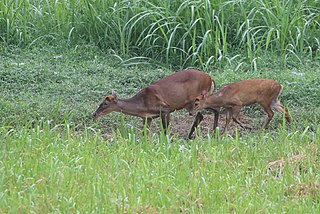
Muntjacs, also known as the barking deer or rib-faced deer, are small deer of the genus Muntiacus native to South Asia and Southeast Asia. Muntjacs are thought to have begun appearing 15–35 million years ago, with remains found in Miocene deposits in France, Germany and Poland. Most are listed as least-concern species or Data Deficient by the International Union for Conservation of Nature (IUCN), although others such as the black muntjac, Bornean yellow muntjac, and giant muntjac are vulnerable, near threatened, and Critically Endangered, respectively.
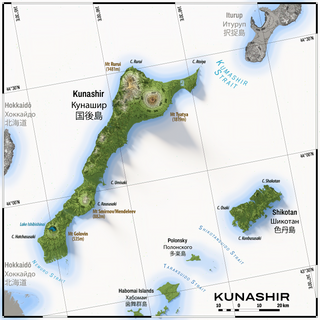
Kunashir Island, possibly meaning Black Island or Grass Island in Ainu, is the southernmost island of the Kuril Islands archipelago. The island has been under Russian administration since the end of World War II, when Soviet forces took possession of the Kurils. It is claimed by Japan.

Iturup, also historically known by other names, is an island in the Kuril Archipelago separating the Sea of Okhotsk from the North Pacific Ocean. The town of Kurilsk, administrative center of Kurilsky District, is located roughly midway along its western shore. Iturup is the largest and northernmost of the southern Kurils, ownership of which is disputed by Japan and Russia. It is located between Kunashiri 19 km (12 mi) to its southwest and Urup 37 km (23 mi) to its northeast. The Vries Strait between Iturup and Urup forms the Miyabe Line dividing the predominant plants of the Kurils.
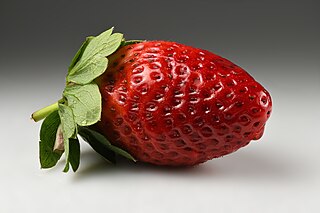
The garden strawberry is a widely grown hybrid species of the genus Fragaria, collectively known as the strawberries, which are cultivated worldwide for their fruit. The fruit is widely appreciated for its characteristic aroma, bright red color, juicy texture, and sweetness. It is consumed in large quantities, either fresh or in such prepared foods as jam, juice, pies, ice cream, milkshakes, and chocolates. Artificial strawberry flavorings and aromas are also widely used in products such as candy, soap, lip gloss, perfume, and many others.

Fragaria iturupensis, the Iturup strawberry, is a species of wild strawberry, endemic to Iturup in the Kuril Islands. It is noted to have relatively large berries for a wild species, similar in appearance to those of Fragaria virginiana.

The musk strawberry or hautbois strawberry, is a species of strawberry native to Europe. Its French name hautbois strawberry may be anglicised as hautboy strawberry. The plants are hardy and can survive in many weather conditions. They are cultivated commercially on a small scale, particularly in Italy. The fruit are small and round; they are used in the gourmet community for their intense aroma and flavour, which has been compared to a mixture of regular strawberry, raspberry and pineapple. Popular cultivated varieties include 'Capron' and 'Profumata di Tortona'.

Fragaria vesca, commonly called the wild strawberry, woodland strawberry, Alpine strawberry, Carpathian strawberry or European strawberry, is a perennial herbaceous plant in the rose family that grows naturally throughout much of the Northern Hemisphere, and that produces edible fruits.
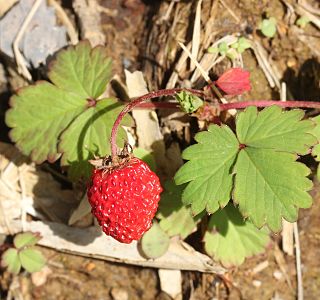
Fragaria iinumae is a species of strawberry native to Japan and eastern Russia.

Fragaria nipponica is a species of wild strawberry native to the western side of the Japanese island of Honshū, with a variety Fragaria nipponica var. yakusimensis on Yakushima. Some botanists treat it as a synonym of Fragaria yezoensis.
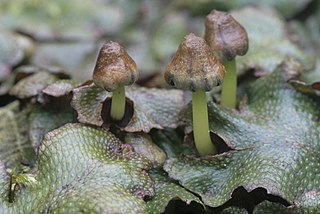
Conocephalum is a genus of complex thalloid liverworts in the order Marchantiales and is the only extant genus in the family Conocephalaceae. Some species of Conocephalum are assigned to the Conocephalum conicum complex, which includes several cryptic species. Conocephalum species are large liverworts with distinct patterns on the upper thallus, giving the appearance of snakeskin. The species Conocephalum conicum is named for its cone-shaped reproductive structures, called archegoniophores. Common names include snakeskin liverwort, great scented liverwort and cat-tongue liverwort.

The American Elm cultivar Ulmus americana 'Jefferson' was cloned from a tree growing near a path in front of the Freer Gallery of Art, close to the Smithsonian Institution Building on the National Mall in Washington, D.C. The United States National Park Service, which had planted the tree during the 1930s, cloned it in 1993 after screening tests showed that it possessed an outstanding level of tolerance to Dutch elm disease (DED).

Salix arbutifolia, synonym Chosenia arbutifolia, is a flowering plant in the family Salicaceae, native to Japan, Korea, northeastern China, Siberia and the Russian Far East. It has been treated as the sole member of genus Chosenia.

Karenia is a genus that consists of unicellular, photosynthetic, planktonic organisms found in marine environments. The genus currently consists of 12 described species. They are best known for their dense toxic algal blooms and red tides that cause considerable ecological and economical damage; some Karenia species cause severe animal mortality. One species, Karenia brevis, is known to cause respiratory distress and neurotoxic shellfish poisoning (NSP) in humans.
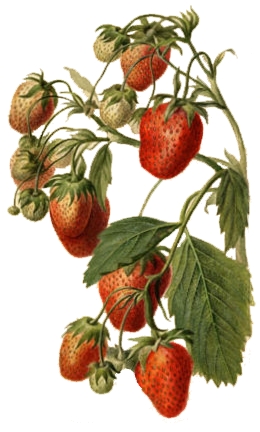
The breeding of strawberries started with the selection and cultivation of European strawberry species in western Europe in the 15th century while a similar discovery and cultivation occurred in Chile. The most commonly consumed strawberry species in modern times is the garden strawberry, a species derived from hybridization of two other species, with the scientific name Fragaria × ananassa, but there are many species of strawberries, several others of which are cultivated to some extent. The strawberry species fall into several different genetic types, based on their number of chromosomes. Strawberry growers have employed many breeding techniques, starting with traditional plant breeding and then moving on to molecular breeding and genetic engineering in the 20th century.

Strawberries in the United States are almost entirely grown in California – 86% of fresh and 98% of frozen in 2017 – with Florida a distant second. Of that 30.0% was from Monterey, 28.6% from Ventura, 20.0% from Santa Barbara, 10.0% from San Luis Obispo, and 9.2% from Santa Cruz. The Watsonville/Salinas strawberry zone in Santa Cruz/Monterey, and the Oxnard zone in Ventura, contribute heavily to those concentrations.





















